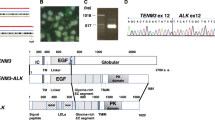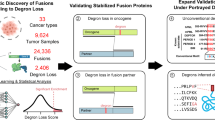Abstract
The search for tumour–specific markers is one of the chief goals in cancer biology. We show that the translocation t(12;16)(q13:p11) in malignant myxoid liposarcoma can be a fusion of the CHOP dominant negative transcription factor gene with a novel gene, FUS, which can result in fusion of the FUS glycine–rich protein with the whole CHOP coding region. The data support the concept that protein fusion may commonly occur in solid tumours resulting in tumour–specific markers of potential clinical importance. The data also indicate the importance of transcription disruption in the pathogenesis of solid tumours.
This is a preview of subscription content, access via your institution
Access options
Subscribe to this journal
Receive 12 print issues and online access
$209.00 per year
only $17.42 per issue
Buy this article
- Purchase on Springer Link
- Instant access to full article PDF
Prices may be subject to local taxes which are calculated during checkout
Similar content being viewed by others
References
Nowell, P.C. & Hungerford, D.A. A minute chromosome in human chronic granulocytic leukaemia. Science 132, 1497 (1960).
Mitelman, F. Catalogue of Chromosome Aberrations in Cancer. (Wiley-Liss, New York, 1991).
Heim, S. & Mitelman, F. Cytogenetics of solid tumours. Rec. Adv. Path. 3, 37–66 (1991).
de Klein, A. et al. A cellular oncogene is translocated to the Philadelphia chromosome in chronic myelocytic leukaemia. Nature 300, 765–767 (1982).
Bartram, C.R. et al. Translocation of c-abl oncogene with the presence of a Philadelphia chromosome in chronic myelocytic leukaemia. Nature 306, 277–280 (1983).
Groffen, J. et al. Philadelphia chromosomal breakpoints are clustered within a limited region, bcr, on chromosome 22. Cell 36, 93–99 (1984).
Taub, R. et al. Translocation of the c-myc gene into the immunoglobulin heavy chain locus in human Burkitt's lymphoma and murine plasmacytoma cells. Proc. natn. Acad. Sci. U.S.A. 79, 7837–7841 (1982).
Dalla-Favera, R. et al. Human c-myc oncogene is located on the region of chromosome 8 that is translocated in Burkitt lymphoma cells. Proc. natn. Acad. Sci. U.S.A. 79, 7824–7827 (1982).
Hamlyn, P.H. & Rabbitts, T.H. Translocation joins c-myc and immunoglobulin γl genes in a Burkitt's lymphoma revealing a third exon in the c-myc oncogene. Nature 304, 135–139 (1983).
Davis, M., Malcolm, S. & Rabbitts, T.H. Chromosome translocation can occur on either side of the c-myc oncogene in Burkitt lymphoma. Nature 308, 286–288 (1984).
Taub, R. et al. A novel alteration in the structure of an activated c-myc gene in a variant t(2;8) Burkitt lymphoma. Cell 37, 511–520 (1984).
Croce, C.M. et al. Transcriptional activation of an unrearranged and untranslocated c-myc oncogene by translocation of a Cλ, locus in Burkitt lymphoma cells. Proc. natn. Acad. Sci. U.S.A. 80, 6922–6926 (1983).
Rabbitts, T.H. Translocations, master genes, and differences between the origins of acute and chronic leukaemias. Cell 67, 641–644 (1991).
Cleary, M.L. Oncogenic conversion of transcription factors by chromosomal translocations. Cell 66, 619–622 (1991).
Kamps, M.P. et al. A new homeobox gene contributes the DNA binding domains of the t(1 ;19) translocation protein in pre-B ALL. Cell 60, 547–555 (1990).
Nourse, J. et al. Chromosomal translocation t(1; 19) results in synthesis of a homeobox fusion mRNA that codes for a potential chimeric transcription factor. Cell 60, 535–545 (1990).
Borrow, J., Goddard, A.D., Sheer, D. & Solomon, E. Molecular analysis of acute promyelocytic leukemia breakpoint cluster region on chromosome 17. Science 249, 451–458 (1990).
de The, H., Chomienne, C., Lanotte, M., Degos, L. & Dejean, A. The t(15;17) translocation of acute promyelocytic leukaemia fuses the retinoic acid receptor α gene to a novel transcribed locus. Nature 347, 558–561 (1990).
Alcalay, M. et al. Translocation breakpoint of acute promyelocytic leukaemia lies within the retinoic acid receptor α locus. Proc. natn. Acad. Sci. U.S.A. 88, 1977–1981 (1991).
Erickson, P. et al. Identification of breakpoints in t(8;21) acute myelogenous leukemia and isolation of a fusion transcript AML-1/ETO, with similarity to Drosophila segmentation gene, runt. Blood 80, 1825–1831 (1992).
Miyoshi, H. et al. The t(8;21) translocation in acute myeloid leukemia results in production of an AML1-MTG8 fusion transcript EMBO J. (in the press).
von Lindern, M. et al. The translocation (6;9) associated with a specific subtype of acute myeloid leukemia, results in the fusion of two genes, dek and can, and the expression of a chimeric leukemia-specific dek-can mRNA. Molec. cell. Biol. 12, 1687–1697 (1992).
Delattre, O. et al. Gene fusion with an ETS DNA-binding domain caused by chromosome translocation in human tumours. Nature 359, 162–164 (1992).
Aman, P. et al. Rearrangement of the transcription factor gene CHOP in myxoid liposarcomas with t(12;16)(q13;p11). Genes, Chrom. Cancer 5, 278–285 (1992).
Ron, D. & Habener, J.F. CHOP, a novel developmentally regulated nuclear protein that dimerises with transcription factors C/EBP and LAP and functions as a dominat-negative inhibitor of gene transcription. Genes Dev. 6, 439–453 (1992).
Park, J.S. et al. Isolation, characterisation and chromosomal localisation of the human GADD153 gene. Gene 116, 259–267 (1992).
Eneroth, M. et al. Localisation of the chromosome breakpoints of the t(12;16) in liposarcomas to sub-bands 12q 13.3 and 16p11.2. Cancer Genet. Cytogent. 48, 101–107 (1990).
Dube, I.D. et al. A novel human homeobox gene lies at the chromosome 10 breakpoint in lymphoid neoplasias with chromosomal translocation t(10;14). Blood 78, 2992–3003 (1991).
Kennedy, M. et al. HOX11, a homeobox-containing T-cell oncogene on human chromosome 10q24. Proc. natn. Acad. Sci. U.S.A. 88, 8900–8904 (1991).
Hatano, M., Roberts, C.W.M., Minden, M., Crist, W.M. & Korsmeyer, S.J. Deregulation of a homeobox gene, HOX11, bythet(10;14) in T cell leukaemia. Science 253, 70–82 (1991).
Lu, M., Gong, Z., Shen, W. & Ho, A.D. The tcl-3 proto-oncogene altered by chromosomal translocation in T-cell leukaemia codes for a homeobox protein. EMBO J. 10, 2905–2910 (1991).
Rieger, M. & Franke, W.W. Identification of an orthologous mammalian cytokeratin gene. J. molec. Biol. 204, 841–856 (1988).
Mitchell, P.J. & Tijan, R. Transcriptional regulation in mammalian cells by sequence-specific DNA binding proteins. Science 245, 371–378 (1989).
Rabbitts, T.H. & Boehm, T. Structural and functional chimerism results from chromosomal translocation in lymphoid tumours. Adv. Imm. 50, 119–146 (1991).
Barr, F.G. et al. Rearrangement of the PAX3 paired box gene in the paediatric solid tumour alveolar rhabdomyosarcoma. Nature Genet. 3, 113–117 (1993).
Trent, J.M. & Meltzer, P.S. The last shall be first. Nature Genet. 3, 101–102 (1993).
Southern, E.M. Detection of specific sequences among DNA fragments separated by gel electrophoresis. J. molec. Biol. 98, 503–517 (1975).
Feinberg, A.P. & Vogelstein, B. A technique for radiolabelling DNA restriction endonuclease fragments to high specific activity. Anal. Biochem. 132, 6–13 (1983).
Buroker, N.E. et al. Four restriction fragment length polymorphisms revealed by probes from a single cosmid map to human chromosome 12q. Hum. Genet. 72, 86–91 (1986).
Spurr, N.K. & Rooke, L. Confirmation of assignment of vitronectin and fibronectin receptor α-subunits. Ann. hum. Genet. 55, 217–223 (1991).
Povey, S. et al. Assignment of the human locus defining phosphoglycolate phosphotase to chromosome 16. Ann. hum. Genet. 43, 241–248 (1980).
Mulley, J.C. & Callen, D.F. New regional localisation for HAGH and PGP on human chromosome 16. Ann. Genet. 29, 235–241 (1986).
Thomas, P.S. Hybridisation of denatured RNA and small DNA frgaments transferred to nitrocellulose. Proc. natn. Acad. Sci. U.S.A. 77, 5201–5205 (1980).
Bankier, A.T. & Barrell, B.G. Shotgun DNA sequencing methods in Nucleic Acid Sequencing, (eds Howe, C. J. & Wards, E.S.) 78 (IRL Press, Oxford, 1989).
Author information
Authors and Affiliations
Rights and permissions
About this article
Cite this article
Rabbitts, T., Forster, A., Larson, R. et al. Fusion of the dominant negative transcription regulator CHOP with a novel gene FUS by translocation t(12;16) in malignant liposarcoma. Nat Genet 4, 175–180 (1993). https://doi.org/10.1038/ng0693-175
Received:
Accepted:
Issue Date:
DOI: https://doi.org/10.1038/ng0693-175
This article is cited by
-
Laparoscopic resection of a metastatic myxoid liposarcoma in the mesentery of the small intestine: a case report
Surgical Case Reports (2023)
-
Phase separation of low-complexity domains in cellular function and disease
Experimental & Molecular Medicine (2022)
-
Blood-derived lncRNAs as biomarkers for cancer diagnosis: the Good, the Bad and the Beauty
npj Precision Oncology (2022)
-
Establishment of multiplex RT-PCR to detect fusion genes for the diagnosis of Ewing sarcoma
Diagnostic Pathology (2021)
-
Clonal architecture in mesothelioma is prognostic and shapes the tumour microenvironment
Nature Communications (2021)



